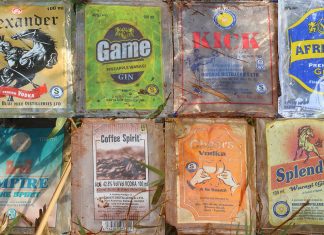On walking tours in Uganda you could discover local villages and explore our cities. Learn about the wildlife, culture and they way of life. Exploring on foot helps to make your trip more responsible. Wildlife safaris in the national parks support the conservation work of the Uganda Wildlife Authority (UWA) but walking tours benefit the local communities. The Uganda Safari Travel Guide paves you the way for your next Eco-adventure. With selected travel offers by officially registered tour operators and local guides.
What type of walking tours are available?
Whether solo, tour group or family, walking experiences are diverse including hiking and canoeing, Kibale forest night walk, cultural trips and nature walks. Normally, these Eco-excursions are undertaken either in national parks, communities or towns.
The highlights include wildlife walking tours in Uganda such as seeing Nubian giraffes, zebras, and impala in Lake Mburo national park and tracking rhinos at Ziwa rhino sanctuary. Kibale forest night walk is safe to see nocturnal animals. Bigodi swamp, which is near Kibale forest offers a nature walk to search for 8 primate species, birds, and Sitatunga. Walks and hikes on the islands of Lake Bunyonyi. In addition, you can have a tour of the city or town such as Kampala, Jinja and Fort Portal. make a tour of the local villages such as
What to expect on walking tours in Uganda?
- The walking tours can range from 1 to 4 hours depending what’s being done, your guide will recommend what to pack.
- You will need a guide or ranger (when in the national parks) to guide you through the tour. Remember to give a tip or donate something.
- Carry your own food and drinks or be ready to taste traditional dishes or street food. Meals can be arranged in the bush.
- Lake Mburo national park offers horseback rides and walks for kids aged 5 years and above.
Where to go for walking tours in Uganda
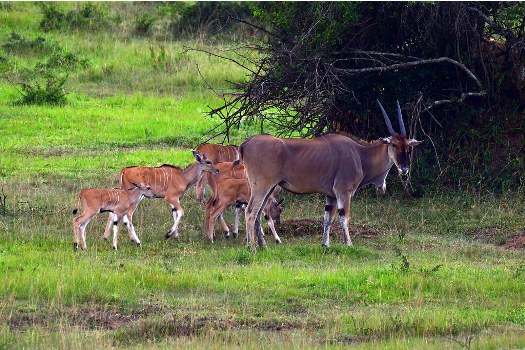
Lake Mburo National Park
The smallest of the 5 savanna protected areas, Lake Mburo National Park perhaps is the best for a bush walking tour. It is the located 30 min drive off the Kampala-Masaka highway. Nshara gate is 238 km (4-hour drive) south west of Kampala capital city. Use Sanga gate when coming from Mbarara city, which is 70 km (1-hour drive away). But, if you will be staying at Mihingo Safari Lodge, make sure to enter via Nshara. Lake Mburo is the only park n the entire western Uganda with Zebras, Nubian giraffes, Elands, and impalas. There are no elephants and lions, making for a safe walking safari.
In addition, the park offers cycling for kids, boat cruise, birding trails, and game drives. Besides spotting wildlife, you can visit a local school or the Ankole longhorn cattle farms at Kamihingo Farm and Mpogo Safari Lodge. Mihingo Safari Lodge offers. Mihingo Safari Lodge offers horse-back riding for children above 4 years.
Bigodi swamp and village Walk
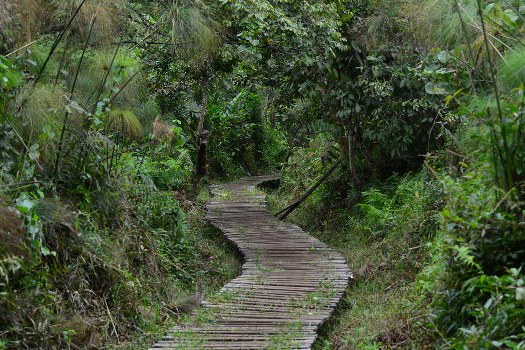
Bigodi wetland sanctuary is 6 km away from Kanyanchu Kibale Forest National Park headquarters. Kibale forest is famous for harboring 13 primate species including chimpanzees, which you visit during chimp tracking or habituation experiences. Bigodi swamp is home to 8 primates such as red colobus monkeys, grey cheeked mangabays, blue monkeys, and black and white colobus monkeys, red tailed monkeys, L’hoest monkeys, olive baboons, and velvet monkeys. You’re likely to see most of these species in Bigodi swamp than in Kibale forest. The boardwalks give access to the interior of the wetland, which is also home to 200 bird species. The nature walk takes 1 to 3 hours depending on the pace and interests. Those spending a night at Primate Lodge can do the Kibale forest night walk to look for nocturnal species.
Bigodi Village walking tour
Here, you get more interaction with local people including basket weavers and a herbalist for his stunning metaphysics. You can plan to visit a school where you can donate scholastic materials. Visit Rest in Banana Gardens in Busimba village to learn how juice and wine is made out of bananas. Also, the Busimba Women Organization offers basket weaving lessons, a good thing for those visiting Kibale with children.
Meeting the Batwa pygmies
Pygmies are the several small-statured people scattered in equatorial rain-forests from west, central to East Africa. The Batwa in particular are a distinct group found in South west Uganda, Rwanda, and parts of eastern DR Congo. In Uganda, they live in Bwindi forest, Mgahinga gorilla, and Echuya forest reserve. They’re also in Semliki national park. Batwa were evicted from the forests between 1991 to 1993 for conservation reasons. They lost their hunter gatherer lifestyle in which food is obtained by hunting, fishing, and foraging rather than by cultivation. With no more access, they became lonely and miserable. Stigmatization in the community was too much. Batwa needed some time to adjust to normal living. By the time help arrived, some had neglected their health due to alcoholism leading to diseases including HIV/AIDS. Through the United Organization for Batwa Development, it would seem relatively easy to give them education, healthcare, and income generating activities. However, the truth is that it’s been hard to bring all of them together for a common goal. There are estimated 3,000 Batwa of which most are found in Kisoro district around Rushaga gorilla sector. Others are still scattered across Kigezi highlands and not part of the agenda.
Walking tours with the Batwa
Tourism has helped to revive their ancient ways of life. By allowing them to train as guides and access the forest on purpose. The Batwa trails can be found in Mgahinga, Bwindi, Echuya forest reserve, and some islands on lake Bunyonyi. In particular for Bwindi go to Buhoma or Nkuringo. Visiting the Batwa cultural experience is also open at Ntanda in Semliki national park.
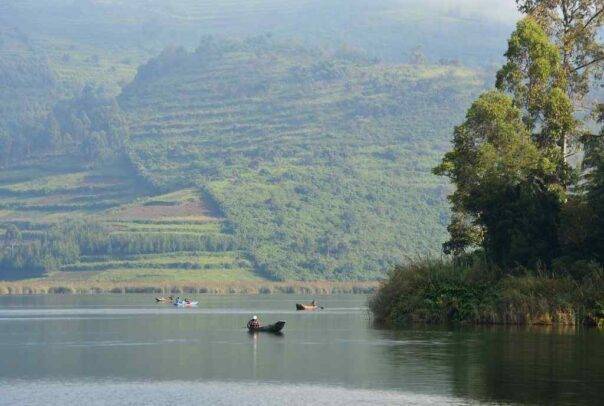
Lake Bunyonyi
Lake Bunyonyi has 19 islands, making for the most beautiful spot of the 6 lava dammed lakes in Kigezi highlands. It offers a wide range of lakeside resorts, camping, and island home-stays. Lakeside lodges include Bunyonyi Rock Resort, Bird Nest resort, and Bunyonyi Safari Resort. It is such a great spot to relax after hiking in the Virungas or tracking the gorillas in Bwindi and Mgahinga. You can do activities such as zip lining, birding (Bunyonyi means a place of many little birds). Canoeing and boat riding offer opportunity to visit Kahugye or punishment islands and learn about their history.
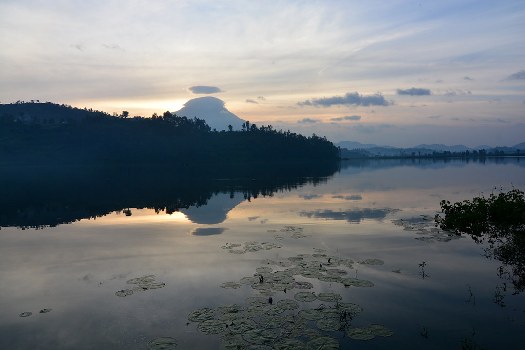
The three upland lakes hike
Embrace yourself to the walking tour of 3 lakes in Kigezi highlands including Kayumbu, Bunyonyi, and Mutanda. For this involves undertaking several activities such as canoe and boat rides visiting islands, hiking, and transfer by car. You can only do so much in a day depending on time and energy. That is the secret of successful sauntering slowly for 3-4 days down the green rolling hills of south western Uganda. The trails will take you off the highways deep into the remote villages over the steep crop fields and hills. There are opportunities to explore landscapes, learn about plants, local food, and culture.
Walking tours in Kampala city
Kampala capital city offers great insights into Uganda’s history from the colonial time to the modern era. The walking tours are available from 2 to 6 hours depending on sites to be visited. You can take alternative tour as well as such as a Boda-boda tour (motorcycle) the quickest way to maneuver through traffic and get to your next destination. While visiting sites like markets, monuments is great, there are new ways to meet locals. Venues can be found for you to showcase your craft or play music on the street.


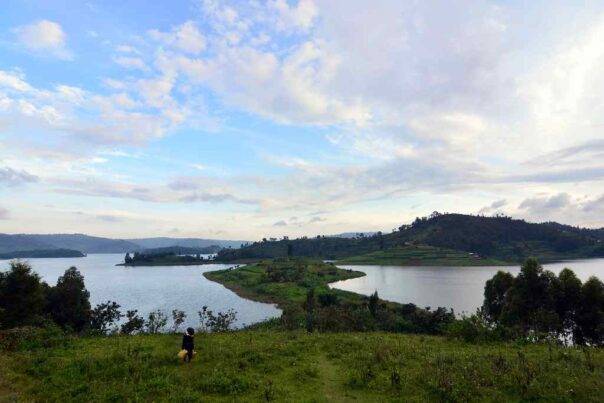
 Uganda Safari Travel Guide Advert
Uganda Safari Travel Guide Advert